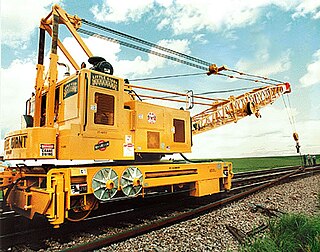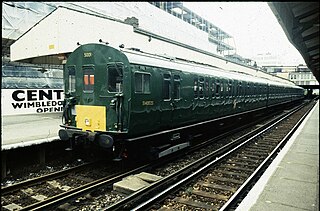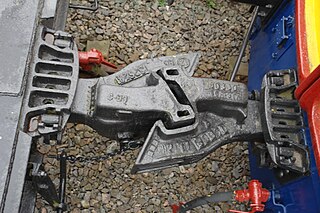Related Research Articles

A caboose is a crewed North American railroad car coupled at the end of a freight train. Cabooses provide shelter for crew at the end of a train, who were formerly required in switching and shunting, keeping a lookout for load shifting, damage to equipment and cargo, and overheating axles.

The Association of American Railroads (AAR) is an industry trade group representing primarily the major freight railroads of North America. Amtrak and some regional commuter railroads are also members. Smaller freight railroads are typically represented by the American Short Line and Regional Railroad Association (ASLRRA), although some smaller railroads and railroad holding companies are also members of the AAR. The AAR also has two associate programs, and most associates are suppliers to the railroad industry.

In railroad terminology, a stock car, cattle car, cattle truck or cattle wagon is a type of rolling stock used for carrying livestock to market. A traditional stock car resembles a boxcar with louvered instead of solid car sides for the purpose of providing ventilation; stock cars can be single-level for large animals such as cattle or horses, or they can have two or three levels for smaller animals such as sheep, pigs, and poultry. Specialized types of stock cars have been built to haul live fish and shellfish and circus animals such as camels and elephants. Until the 1880s, when the Mather Stock Car Company and others introduced "more humane" stock cars, death rates could be quite high as the animals were hauled over long distances. Improved technology and faster shipping times have greatly reduced deaths.

A coupling is a mechanism used to connect rolling stock together in a train.

A tank car is a type of railroad car or rolling stock designed to transport liquid and gaseous commodities.

A railroad crane is a type of crane used on a railroad for one of three primary purposes: freight handling in goods yards, permanent way (PW) maintenance, and accident recovery work. Although the design differs according to the type of work, the basic configuration is similar in all cases: a rotating crane body is mounted on a sturdy chassis fitted with flanged wheels. The body supports the jib and provides all the lifting and operating mechanisms; on larger cranes, an operator's cabin is usually provided. The chassis is fitted with buffing (UK) and/or coupling gear to allow the crane to be moved by a locomotive, although many are also self-propelled to allow limited movement about a work site.
The St. Louis Car Company was a major United States manufacturer of railroad passenger cars, streetcars, trolleybuses and locomotives that existed from 1887 to 1974, based in St. Louis, Missouri.

A rail yard, railway yard, or railroad yard is a complex series of railroad tracks for storing, sorting, or loading and unloading railroad cars and locomotives. Railroad yards have many tracks in parallel for keeping rolling stock or unused locomotives stored off the mainline, so that they do not obstruct the flow of traffic. Railroad cars are moved around by specially designed yard switchers, a type of locomotive. Cars in a railroad yard may be sorted by numerous categories, including railway company, loaded or unloaded, destination, car type, or whether they need repairs. Railroad yards are normally built where there is a need to store cars while they are not being loaded or unloaded, or are waiting to be assembled into trains. Large yards may have a tower to control operations.

Canadian Car and Foundry (CC&F), also variously known as "Canadian Car & Foundry" or more familiarly as "Can Car", was a manufacturer of buses, railway rolling stock, forestry equipment, and later aircraft for the Canadian market. CC&F history goes back to 1897, but the main company was established in 1909 from an amalgamation of several companies and later became part of Hawker Siddeley Canada through the purchase by A.V. Roe Canada in 1957. Today the remaining factories are part of Bombardier Transportation Canada.

Rail transportation in the United States consists primarily of freight shipments, with a well integrated network of standard gauge private freight railroads extending into Canada and Mexico. Passenger service is mainly mass transit and commuter rail in major cities. Intercity passenger service, once a large and vital part of the nation's passenger transportation network, plays a limited role as compared to transportation patterns in many other countries. The United States has the largest rail transport network size of any country in the world.
Shunting, in railway operations, is the process of sorting items of rolling stock into complete trains, or the reverse. In the United States this activity is known as switching.

British Rail Class 415 was a suburban 750 V DC third rail electric multiple unit commissioned by the Southern Region of British Railways. Built between 1951 and 1957, it became the most numerous class on the region after the withdrawal of the 4SUBs. The final trains were withdrawn in the 1990s, replaced by Class 455, 456, 465 and 466.

Coil cars are a specialized type of rolling stock designed for the transport of coils of sheet metal, particularly steel. They are considered a subtype of the gondola car, though they bear little resemblance to a typical gondola.

SA3 couplers are railway rollingstock couplings used primarily in Russia and states influenced by the former Soviet Union, such as Finland and Mongolia.

Donald Joseph McKay Russell was an American railroad executive. He was president of Southern Pacific Railroad from 1952–1964 and then chairman from 1964–1972. Russell was featured on the cover of Time on August 11, 1961 and Forbes on November 1, 1965.

Janney couplers are a semi-automatic form of railway coupling that allow rail cars and locomotives to be securely linked together without rail workers having to get between the vehicles. They are also known as American, AAR, APT, ARA, MCB, knuckle, or center-buffer couplers.
The George R. Henderson Medal was an award established by the Franklin Institute in honor of George R. Henderson in 1924, coinciding with a $2,500 fund for the award contributed by his wife. George R. Henderson served on the Franklin Institute's Committee on Science and the Arts from 1912 until 1921. The award was designated to go to individuals who made significant contributions to railroad engineering.
Thomas H. Morrin was an engineer and the director of engineering at SRI International from 1948 to 1963.

Different types of railroad rolling stock have different couplers depending on the purpose and type of equipment being used and its intended destination. European rolling stock tend to use buffers and chain couplers while American rolling stock uses a Janney coupler or "knuckle coupler". These are incompatible with each other, but where some railroads have obtained older, less expensive used rolling stock from different countries or regions, instead of having to standardize on one form of coupler, it may be useful to be able to use either type of coupler on a piece of rolling stock without having to remove anything.
References
- 1 2 3 4 5 6 7 8 9 10 Nielson, Donald (2006). A Heritage of Innovation: SRI's First Half Century. Menlo Park, California: SRI International. pp. 6-1–6-3. ISBN 978-0-9745208-1-0.
- ↑ Inventor William K. MacCurdy. "Direct-Acting Hydraulic Pneumatic Device". United States Patent and Trademark Office . Retrieved 2012-04-01.
- ↑ Impact tests of cushion underframes and hydrafriction and standard draft gears. Stanford Research Institute. 1955.
- 1 2 "Era of car cushioning began 10 years ago". Railway Age . 1967-02-27. pp. 34–35.
- ↑ "Softer Rides for Rail Freight". SRI Journal. 2 (2). 1958. pp. 44–45.
- ↑ "Railroad Hydra-Cushion". Timeline of Innovations. SRI International . Retrieved 2013-07-01.
- ↑ Modern railroads. 20. 1965. p. 166.
- ↑ "A Research Accomplishment Acknowledged". SRI International. 1964.
- ↑ "Train Museum News" (PDF). Millbrae Life & Times. Millbrae Historical Society. June 2008. Retrieved 2012-04-01.